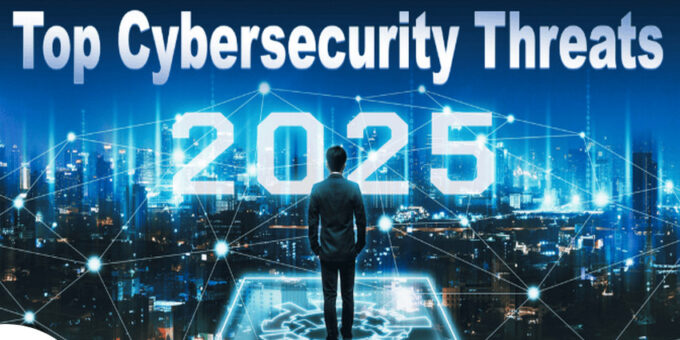
Cyber threats are evolving, making online security more critical than ever. In 2025, cybercriminals are using smarter tactics. Businesses and individuals must stay alert.
1. AI-Powered Cyber Attacks
Hackers now use artificial intelligence to launch attacks. AI automates phishing, making scams harder to detect. Cybercriminals can bypass security using deepfake technology. Businesses must invest in AI-powered defense systems. Multi-layered security helps prevent AI-driven threats.
2. Ransomware Attacks on the Rise
Ransomware is becoming more advanced. Hackers encrypt files, demanding huge payments. Critical infrastructure, like hospitals, faces increased risks. Regular backups and strong security protocols are essential. Multi-factor authentication (MFA) adds another layer of protection.
3. Cloud Security Breaches
More companies rely on cloud storage. Cybercriminals exploit weak configurations to steal data. Misconfigured cloud settings expose sensitive information. Encrypting cloud data enhances security. Strong access controls minimize unauthorized access.
4. Phishing Attacks Becoming More Sophisticated
Phishing scams are more convincing than ever. Attackers use social engineering to trick victims. Emails and messages look legitimate, making detection difficult. Cyber awareness training reduces phishing risks. Always verify suspicious emails before clicking links.
5. Internet of Things (IoT) Vulnerabilities
Smart devices connect homes and businesses. Hackers exploit weak IoT security to gain access. Unsecured devices act as entry points for cybercriminals. Regular firmware updates help fix security flaws. Changing default passwords enhances IoT security.
6. Insider Threats on the Rise
Employees pose significant security risks. Insider threats can be intentional or accidental. Stolen credentials lead to unauthorized access. Companies should monitor employee activity closely. Zero-trust security reduces insider threats.
7. Deepfake Technology Used for Fraud
Cybercriminals use deepfakes to manipulate videos and voices. Fake identities enable fraud and misinformation. Scammers impersonate executives to steal money. AI-powered detection tools help identify deepfakes. Awareness prevents falling for fake media.
8. Supply Chain Attacks Increasing
Hackers target suppliers to breach larger organizations. A weak vendor can expose an entire network. Supply chain security is a growing concern. Businesses must vet third-party partners carefully. Strong cybersecurity policies protect against these threats.
9. Cryptocurrency Scams Expanding
Crypto fraud is increasing worldwide. Fake investment schemes lure unsuspecting victims. Cybercriminals exploit weak exchange security. Strong passwords and cold wallets improve safety. Verifying crypto platforms prevents scams.
10. 5G Network Security Concerns
5G speeds boost connectivity but increase risks. Hackers exploit network vulnerabilities to launch attacks. Strong encryption protects 5G communications. Security patches must be updated regularly. Companies must prioritize 5G security measures.
11. Data Breaches Hitting More Businesses
Companies store vast amounts of sensitive data. Hackers target weak security systems. Stolen data leads to financial and reputational damage. Encrypting data reduces breach risks. Regular security audits improve protection.
12. Social Media Hacking Growing
Hackers exploit social media for identity theft. Weak passwords make accounts easy targets. Social engineering tricks users into revealing credentials. Enabling two-factor authentication enhances security. Avoid clicking suspicious social media links.
13. Cyber Warfare and Nation-State Attacks
Governments engage in cyber warfare. Nation-state hackers target critical infrastructure. Political tensions increase cyber threats. Strong cybersecurity policies help mitigate risks. Collaboration strengthens global cyber defense.
14. Automated Bot Attacks
Cybercriminals use bots for malicious activities. Bots perform credential stuffing and brute-force attacks. Websites with weak security are vulnerable. Captcha systems reduce automated threats. Regular security updates keep bots at bay.
15. Emerging Quantum Computing Threats
Quantum computing threatens traditional encryption. Hackers could break current security protocols. Companies must explore quantum-resistant encryption. Governments invest in post-quantum security research. Staying ahead of this threat is crucial.
How to Stay Protected from Cyber Threats
Cybersecurity threats will only grow in complexity. Staying informed is the first line of defense. Strong passwords, MFA, and encryption are essential. Regular software updates fix security flaws. Businesses must invest in advanced cybersecurity tools.
Cyber awareness training reduces human error. Employees should recognize phishing attempts. Avoid downloading unknown files or clicking suspicious links. Using VPNs enhances online privacy. Backup important data to prevent ransomware losses.
Cybercriminals are always evolving. Staying proactive keeps personal and business data secure. Investing in cybersecurity ensures long-term protection.